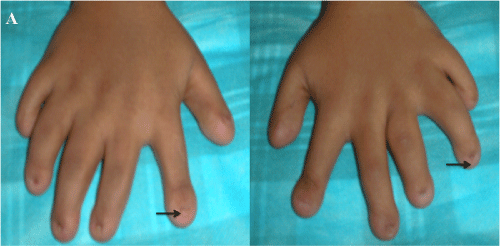
Case Report
Austin J Clin Case Rep. 2014;1(5): 1025.
Ellis-van Creveld Syndrome
Rajiv Ananthakrishna* and Abhijit V Kulkarni
Department of Cardiology, Sri Jayadeva Institute of Cardiovascular Sciences & Research, India
*Corresponding author: Rajiv Ananthakrishna, Department of Cardiology, Sri Jayadeva Institute of Cardiovascular Sciences & Research, Jaya Nagar 9th Block, BG Road, Bangalore 560069, India
Received: May 23, 2014; Accepted: June 30, 2014; Published: July 04, 2014
Abstract
Ellis-van Creveld syndrome is an autosomal recessive disorder characterized by short ribs, short limbs, postaxial polydactyly, ectodermal and heart defects. It is a rare disease caused by defects in the Ellis-van Creveld syndrome genes on chromosome 4. We highlight the typical clinical features of this syndrome.
Keywords: Clinical features; Congenital heart disease; Syndrome
Case Presentation
A 27-year-old female, was referred for evaluation of shortness of breath on exertion of 1 year duration. On examination, she was found to have short stature with a height of 125 cm. Evaluation of hands revealed polydactyly with hypoplasia of nails (Figure A). Syndactyly and clinodactyly are observed in the lower extremities (Figure B). Oral cavity examination disclosed absent maxillary incisors and malformed mandibular incisors (Figure C). The second heart sound was widely split and fixed, with a loud pulmonary component. Two dimensional transthoracic echocardiography was diagnostic of common atrium, with left to right shunt on colour Doppler imaging (Figure D). A clinical diagnosis of Ellis-van Creveld (EVC) syndrome was established based on the tetrad of chondrodystrophy, polydactyly, ectodermal dysplasia and congenital heart defects [1]. Patient was referred for surgical repair of common atrium.
Figure A : Examination of hands revealing polydactyly and hypoplasia of the nails (→).
Figure B : Syndactyly (↓) and clinodactyly (↕) noted in the feet.
Figure C : Visualisation of oral cavity demonstrating absent maxillary incisors and malformed mandibular incisors.
Figure D : Two dimensional transthoracic echocardiography with colour Doppler imaging, illustrating single atrium and left to right shunt across the defect. (SA: Single atrium, RV: Right ventricle, LV: Left ventricle).
Discussion
Ectodermal dysplasias are a large, heterogeneous group of inherited disorders that are defined by primary defects in the development of 2 or more tissues derived from embryonic ectoderm. The tissues primarily involved are the skin and its appendages and teeth. The common ectodermal dysplasias are listed in Table 1. In this report, we illustrate the classical clinical manifestations of EVC syndrome.
Common ectodermal dysplasias
- Hypohidrotic ectodermal dysplasia (Christ-Siemens-Touraine syndrome)
- Hidrotic ectodermal dysplasia (Clouston syndrome).
- Ectodermal dysplasia, ectrodactyly, and clefting (EEC) syndrome.
- Hay-Wells syndrome or ankyloblepharon, ectodermal dysplasia, and cleft lip/palate (AEC) syndrome.
- Rapp-Hodgkin syndrome
- Ellis–van Creveld syndrome
- Naegeli syndrome
- Margarita Island ectodermal dysplasia
Table 1:
EVC syndrome is a rare autosomal recessive condition, caused by defects in one of the two EVC syndrome genes (EVC and EVC2) on chromosome 4 [2]. EVC syndrome belongs to the short rib-polydactyly group. The distinguishing features in EVC syndrome include the combination of both skeletal and ectodermal dysplasia, with congenital heart disease. The spectrum of manifestations of EVC syndrome is highlighted in Table 2.
Clinical manifestations of EVC syndrome
Constant findings
- Chondrodystrophy (disproportionate dwarfism, progressive distal limb shortening affecting the forearm and leg).
- Polydactyly (bilateral and postaxial , observed in the hands in most cases and in the feet in 10% of cases )
- Ectodermal dysplasia (Nails are hypoplastic, can be completely absent in some cases.Tooth involvement may include
neonatal teeth, partial anodontia, small teeth, and premature eruption of malformed maxillary incisors).
- Congenital cardiac anomalies (most common anomaly is a common atrium).
Other manifestations
- Polycarpaly (a ninth or tenth carpal bone), clinodactyly (bent fingers) and syndactyly.
- Musculoskeletal anomalies (short ribs, narrow thorax, knock knees, lumbar lordosis).
- Genitourinary anomalies (hypospadias, cryptorchidism, nephrocalcinosis, renal agenesis)
- Oral manifestations (absence of mucobuccal fold , hyperplastic frenula, multiple frenula, gingival hypertrophy )
- Mental retardation
Table 2:
More than 50% of individuals with EVC syndrome have a congenital heart malformation, which is commonly a single atrium. The main determinants of longevity in EVC syndrome are the presence of heart disease and thoracic dysplasia. The management of such patients is multidisciplinary. This case highlights the typical manifestations of this rare syndrome.
References
- Baujat G, Le Merrer M. Ellis-van Creveld syndrome. Orphanet J Rare Dis. 2007; 2: 27.
- Ruiz-Perez V, Tompson S, Blair H, Espinoza-Valdez C, Lapunzina P, Silva E, et al. Mutations in two nonhomologous genes in a head-to-head configuration cause Ellis-van Creveld syndrome. Am J Hum Genet. 2003; 72: 728-732.



